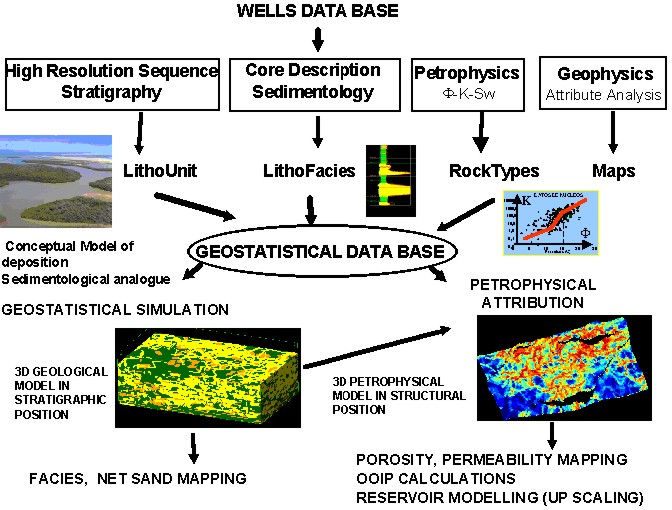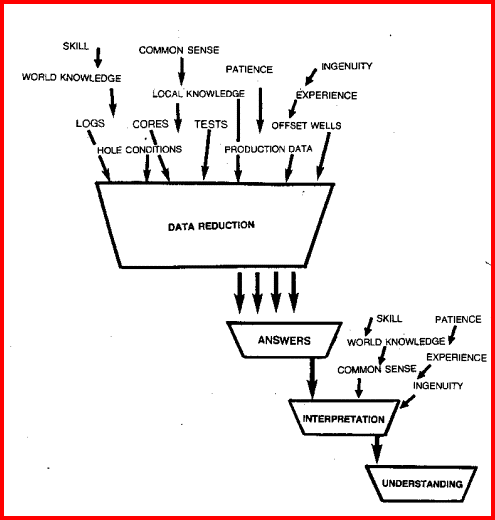|
 WHAT IS
INTEGRATED PETROPHYSICS?
WHAT IS
INTEGRATED PETROPHYSICS?
Petrophysics
is the study of the physical and chemical properties of rocks and
their included fluids, if any. Petrophysical data can be obtained
from well logs and from laboratory data.
Petrophysical data is used both qualitatively and quantitatively.
Both forms are discussed in appropriate sections of this Handbook.
Although
"petrophysics" was used by G. E.
Archie in the 1940's, the word has only become popular in the
last 20 years. The terms "log interpretation" or "log analysis" are
widely used in the literature (inaccurately) to mean the same thing.
Petrophysics is a more inclusive term, encompassing core analysis,
sample descriptions, X-ray diffraction, petrography, scanning
electron microscopy, and other forms
of detailed laboratory data, in addition to well log data. lab data
can also be considered as a "well log", because the depth of each
sample is usually known.
The term "Integrated Petrophysics" is now widely used to suggest
that all forms of rock physics data is being analyzed in a coherent
fashion. In some cases, an adequate log analysis model cannot be
constructed without the integration of XRD, thin section
petrography, geochemistry (organic carbon), electrical properties,
and capillary pressure measurements, in addition to the more
conventional core porosity and permeability measurements.
 Petrophysicists offer services in the areas of well logging supervision,
log analysis and interpretation, computer analysis of logs, seismic
modeling, synthetic seismograms, and reconciliations of log data
with geological, geophysical and exploration prospects, field
studies and simulations, reserves estimates, and submissions to
regulatory agencies. Petrophysicists offer services in the areas of well logging supervision,
log analysis and interpretation, computer analysis of logs, seismic
modeling, synthetic seismograms, and reconciliations of log data
with geological, geophysical and exploration prospects, field
studies and simulations, reserves estimates, and submissions to
regulatory agencies.
These services are essential functions in
modern oil and gas companies and cannot be accomplished without
input from trained petrophysicists. The financial health and long-term
success of a company depends on the central role of petrophysicist
in all aspects of the company’s exploration and development
activities.

Where petrophysics fits in the
scheme of reservoir description (courtesy of GeoNeurale)
 DATA REDUCTION
DATA REDUCTION
 Well
log and lab data seldom tell us what we really want to know. They
might tell us the resistivity and density of a rock. These are
nice things to know but are not the final answers. We really want to
know if there is oil or gas in that rock, how much is present, how fast can
it be produced, and will it make a profit while doing so. Logs and
lab data alone cannot tell us! Well
log and lab data seldom tell us what we really want to know. They
might tell us the resistivity and density of a rock. These are
nice things to know but are not the final answers. We really want to
know if there is oil or gas in that rock, how much is present, how fast can
it be produced, and will it make a profit while doing so. Logs and
lab data alone cannot tell us!
Thus the art and science of "petrophysical analysis" was born. A
petrophysicist is the person who does the analysis of the data. Log
analysis and log analyst are terms still widely used as synonyms.
"Inte
grated Petrophysics" is the most recent buzzword, but is a
little redundant, as the combined use of well logs and lab data has
always been a fact of life for anyone trying to calibrate well log
analysis results to "ground truth".
INTEGRATED PETROPHYSICS

After analysis comes answers, and
after answers comes interpretation, followed hopefully
by understanding. This Handbook
deals mostly
with data analysis. The numerous
case histories will provide the
material
needed
to interpret and understand your results.
Data
analysis, or data reduction, gives us "answers" that can be
ambiguous at best or dead-wrong at worst. To consider "answers" as
the final result of petrophysics is not adequate; the answers have
to make sense when compared to all known facts and probably need
calibration to those other facts. This step may be iterative, so
petrophysical analysis is usually not a one-pass process. . The next step is to
interpret the answers, and hopefully, gain an understanding of the
answers. There is a huge gulf between getting answers and
understanding the answers. Most of this Handbook deals with getting
answers. However, numerous case histories are provided to help start
the understanding process. Trial and error, experience, and a great
memory will continue the process.
 "CSI" PETROPHYSICS
"CSI" PETROPHYSICS
 Petrophysics is much like crime scene investigation (CSI). In the
early days, we used Sherlock Holmes as our model detective
Today, CSI shows on television (every channel, every night) show us
how to gather evidence, analyze it in the lab, draw conclusions from the
evidence, eliminate the impossible and improbable, and finally
understand "who-dun-it". By treating petrophysics in the same
fashion, we can use proven scientific methods to reduce doubt and
uncertainty, but of course never eliminate them entirely. We still
convict the innocent once in a while. Petrophysics is much like crime scene investigation (CSI). In the
early days, we used Sherlock Holmes as our model detective
Today, CSI shows on television (every channel, every night) show us
how to gather evidence, analyze it in the lab, draw conclusions from the
evidence, eliminate the impossible and improbable, and finally
understand "who-dun-it". By treating petrophysics in the same
fashion, we can use proven scientific methods to reduce doubt and
uncertainty, but of course never eliminate them entirely. We still
convict the innocent once in a while.
Calgary Herald cartoon circa 1978, showing the public's impression
of reservoir evaluation. That's me in the parka, looking into the
borehole, while supervising a logging crew for PanArctic Oils Ltd on
Melville Island in the Canadian High Arctic.
By integrating the data from other
geoscience disciplines, we can do more than mere log analysis. We
can actually define the rocks and fluids AND calibrate our work.
When
petrophysics, in its inclusive sense, is combined with depositional
environment, well performance, and pressure data, the result is
called "reservoir description" or "reservoir
characterization", and often leads to a reservoir
simulation or full-field study.

Integrated Petrophysics is more than mere log analysis
State of the art well log analysis involves the intelligent use
of a multiplicity of log curves and lab data in complex computer programs which
evaluate many unknowns at once. Calibration of results usually
requires statistical analysis, correlating laboratory and log
analysis parameters. Sophisticated analysis of this
type requires highly trained technical staff for programming,
data entry, and evaluation. Software is often deterministic,
using a fixed or user-defined sets of mathematical equations to
derive answers from raw data and parameters supplied by the analyst.
Other programs use probabilistic, statistical, or neural network
methods, in addition to some deterministic code, to obtain answers.
No known software can do the interpretation and understanding phase
of the job - that is up to YOU.
To reduce dependence on the expertise
of the programmer and user, a number of companies are studying
the use of artificial intelligence (expert systems) to guide less
experienced analysts through the analysis procedures. However,
after more than 25 years of research, none have become commercial
products.
|

